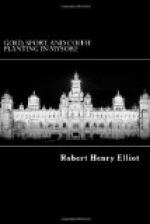It is impossible to refrain from contrasting these falls with those at Gairsoppa. The Cauvery Falls have indeed much beauty and grandeur in river, and varied waterfall scenery, and had I not seen the Gairsoppa Falls I should have thought that it would have been difficult to find anywhere in the world scenes more varied and beautiful. But the beauties of the falls of Cauvery are set in comparatively speaking sterile surroundings of rock and scrubby jungle, trees and shrubs scattered over ground partly undulating, and partly over hills of moderate height and uninteresting form. Then the grandeur arising from their great height, and the charms of the varied sounds of the falls of Gairsoppa, and the marvellously beautiful effects of graceful bird life wheeling and darting amidst the iris hues of the falls, and the setting of the whole scene amidst the tropical wealth of the evergreen forest of the Western Ghauts, afford combinations which far exceed those of the Cauvery Falls. I have no hesitation in saying, as a traveller to the falls of Gairsoppa has said before, that they alone would repay one for all the trouble of the voyage to India. But, beautiful and grand as they undoubtedly are, I cannot quite say the same of the Cauvery falls, though I can with confidence say that if the traveller leaves India without seeing them he will certainly have missed one of the scenes best worth seeing in it.
After spending some time at the Bar Chuckee Falls I then drove back to the bungalow and, leaving the carriage there, walked rather more than half a mile to the bridge which connects the island with the Madras side of the river, and which I closely examined, as it is a most curious and interesting specimen of the work of native engineers, and as it has withstood the floods of about seventy years, one of which passed over the roadway of the bridge to a depth of three feet, is most highly creditable to native workmanship. A similar bridge connects the island with the Mysore side of the river, and both bridges were repaired at his own cost by a native in the employ of the Mysore Government, who in recognition of this important work, received from the British Government, for himself and his heirs (who are bound to keep up the bridges) land yielding an annual revenue of L800, and of L900 from the Mysore Government.
The bridge I now proceeded to examine. It is built entirely of stone without any mortar or cement, and is supported on two rows of single block stone pillars standing on slabs of stone placed on the river bed. Those pillars are about nine feet high and eight feet apart. On the top of each pillar is first of all a thick block of stone projecting about eighteen inches from the pillar on its upper and lower sides. Then on this was a rather thicker block of stone, and on the top of all cross beams of solid single stones had been laid, and from one cross beam to another were solid and closely put together slabs of stones, some of which were eighteen inches wide,




